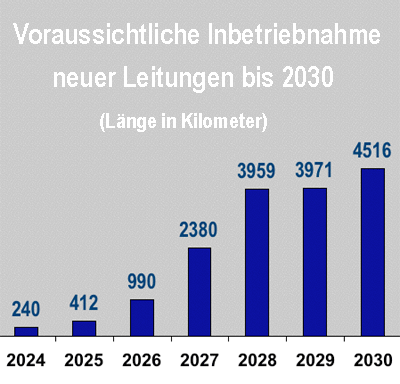 |
October 2025 |
251009 |
ENERGIE-CHRONIK |
|
On October 10, the Federal Network Agency completed the planning approval process for the final section of the approximately 700-kilometer-long high-voltage direct current (HVDC) transmission line “SuedLink.” This means that the transmission system operator TransnetBW, which is responsible for this approximately 76-kilometer section at the southern end of the “electricity highway,” can now begin construction of the underground cable, after having already started construction of the Großgartach/Leingarten converter station in July 2023, which will convert the 525 kV direct current back into alternating current and feed it into the normal 380 kV transmission grid (230709).
SuedLink consists of two direct current lines, each with a transmission capacity of 2 gigawatts, and is the largest direct current project currently being implemented. One line connects Brunsbüttel in Schleswig-Holstein with Großgartach/Leingarten in Baden-Württemberg. The other runs from Wilster to Bergrheinfeld in Bavaria. The Neckarwestheim 2 (230404) and Grafenrheinfeld (150606) nuclear power plants used to feed a similar amount of power into these two network nodes. In the future, this power will be generated by wind turbines in the north and transported to southern Germany via the two HVDC bridges.
Both lines will be laid as underground cables. For the most part, they will run parallel to each other on a shared route. The transmission system operator TenneT is responsible for the northern section and the three converter stations in Schleswig-Holstein and Bavaria. TransnetBW is responsible for the southern section and the converter station in Baden-Württemberg. (210808)
The lines are to be connected to the grid by 2028. Since December 2022, the Federal Network Agency has approved 30 applications for early start of construction. This has enabled initial construction work to begin at an early stage, primarily nature conservation compensation measures, underboring, and clearing work.
Near Glücksstadt, a 5.5-kilometer-long, walkable cable tunnel is being laid under the Elbe River for the SuedLink (230915). Between Bad Friedrichshall and Leingarten, the line runs for 16 kilometers inside the mine of Südwestdeutsche Salzwerke AG. New shafts and tunnels were dug into the mountain to lay the cables towards the Großgartach grid connection point.
|
On July 25, the Federal Network Agency had already completed the planning approval process for the final section of the SuedOstLink HVDC transmission line. In the future, this power line will transport high-voltage direct current from northeastern Germany to Bavaria over a distance of approximately 543 kilometers. It begins in Wolmirstedt (Saxony-Anhalt) and ends at the Isar substation (Bavaria). Commissioning is planned for 2027. Construction had already begun on the previously approved sections . (231003)
Furthermore, all sections of the 305-kilometer-long A-Nord direct current connection from Emden (Lower Saxony) to Osterath (North Rhine-Westphalia) have been finally approved since April 15. It has a transmission capacity of 2 gigawatts. Commissioning is scheduled for 2027. The A-Nord is intended to transport wind power from northwestern Germany and the North Sea to the western German consumption centers on the Rhine and Ruhr.
On August 28, the Federal Network Agency approved the section from Rommerskirchen to the state border of North Rhine-Westphalia for the “Ultranet” HVDC line continuing from Osterath to Philippsburg. This means that the two responsible transmission system operators, Amprion and TransnetBW, now only need approval for the section leading through Rhineland-Palatinate to Philippsburg in Baden-Württemberg. The approximately 340-kilometer-long Ultranet direct current line largely uses an existing extra-high voltage route. Together with the A-Nord line ending in Osterath, it forms the so-called Corridor A, which runs from Emden to Philippsburg. (231001)